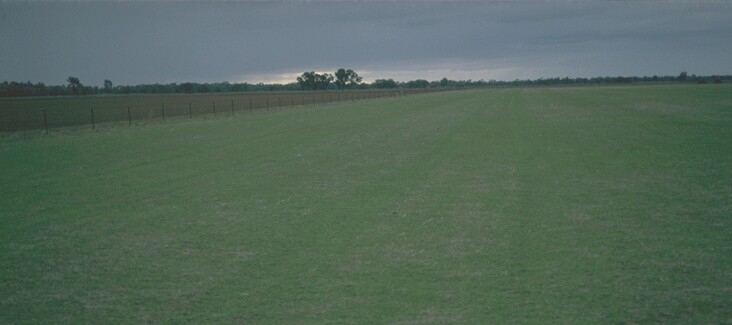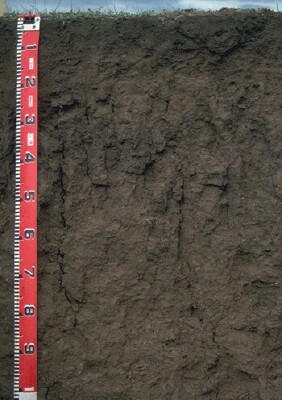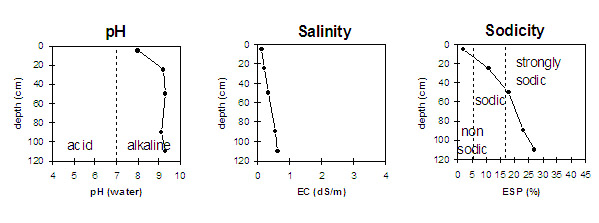LP69
| Group: Oakvale Farm Advance Group | Australian Soil Classification: Epicalcareous-Endohypersodic, Epipedal Grey VERTOSOL |
| Northcote Factual Key: Ug3.2/Ug5.2 | Great Soil Group: grey clay |
| General Landscape Description: Level plain which originally displayed gilgai (i.e. "crabholey") microrelief. Original vegetation included Black Box (Eucalyptus largiflorens) and lignum bush (Muehlenbeckia cunninghamii). Sandstone (fossiliferous) occurs some 10 metres below the surface. | |
 LP69 Landscape |
Soil Profile Morphology
Surface Soil
| A1 | 0-10 cm | Dark brown (7.5YR4/2); light medium clay; cracking surface condition; moderate blocky structure; firm consistence dry; pH 8.0; abrupt change to: |  LP69 Profile |
| NOTE: A discontinuous bleached fine sandy clay loam A2 horizon occurs in patches. | |||
| B21 | 10-40 cm | Dark brown (7.5YR4/2); medium heavy clay; moderate very coarse prismatic, parting to moderate coarse blocky structure; very strong consistence dry; contains a few (2%) carbonate nodules (2-3 mm diameter); pH 9.2; gradual change to: | |
| B22 | 40-100 cm | Dark brown (7.5YR4/2); medium heavy clay; moderate coarse blocky structure; very strong consistence; contains a few (2-5%) amount of carbonate nodules (2-10 mm diameter); slickensides present at depth; pH 9.3; clear change to: | |
| B23 | 100+ cm | Yellowish red (5YR5/6) and reddish brown (5YR5/3); medium heavy clay; very strong consistence dry; contains a few (2-5%) carbonate nodules (2-10 mm diameter); many slickensides present as well as bands of sand throughout the horizon; pH 9.3. | |
Note: The soil is likely to vary across the paddock in response to the gilgai microrelief. Amounts of carbonate and salts are usually higher in the gilgai mounds than in the depressions.
Key Profile Features
- High clay content throughout soil profile.
- Vertic properties (i.e. slickensides, cracking)
Soil Profile Characteristics
pH | Salinity Rating | |||
Surface (A1 horizon) | moderately alkaline | very low | non-sodic | none1 |
Subsoil (25-45 horizon) | very strongly alkaline | low | sodic | none2 |
Deeper subsoil (1 m) | very strongly alkaline | low-medium | strongly sodic | slight |
| 1 Dispersion occurs after remoulding. 2 Strong dispersion with remoulding. | ||||
 |
Horizon | Horizon Depth | pH (water) | pH CaCl2 | EC 1:5 | NaCl | Exchangeable Cations | |||
Ca | Mg | K | Na | ||||||
meq/100g | |||||||||
A1 | 0-10 | 8 | 7.3 | 0.12 | 15 | 7.2 | 2.2 | 0.5 | |
B21 | 10-40 | 9.2 | 8.1 | 0.21 | 15 | 10 | 0.9 | 3.2 | |
B22 | 40-60 | 9.3 | 8.2 | 0.33 | <0.05 | 12 | 10 | 1 | 5 |
B22 | 80-100 | 9.1 | 8.2 | 0.54 | 0.06 | 11 | 9.2 | 1.3 | 6.3 |
B23 | 100+ | 9.3 | 8.4 | 0.63 | 0.07 | 8.3 | 10 | 1.5 | 7.3 |
Horizon | Horizon Depth | Field Capacity pF2.5 | Wilting Point pF4.2 | Coarse Sand (0.2-2.0mm) | Fine Sand (0.02-0.2mm) | Silt (0.002-0.02mm) | Clay (<0.002mm) |
A1 | 0-10 | 31.8 | 19.4 | 5 | 34 | 12 | 45 |
B21 | 10-40 | 39.4 | 25.6 | 3 | 22 | 8 | 56 |
B22 | 40-60 | ||||||
B22 | 80-100 | ||||||
B23 | 100+ |
Comments from Landholder:
- Soil is representative of plains.
- Crops yield up to average two tonnes per acre.
- Gypsum has not been used. Stubble retention is practised.
- Profile described by Mark Imhof, Paul Rampant and Sonia Thompson (25/5/95).


